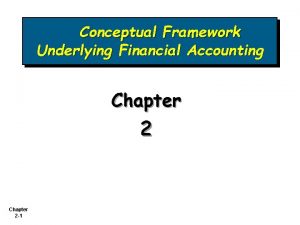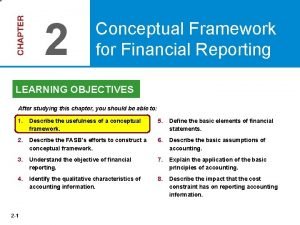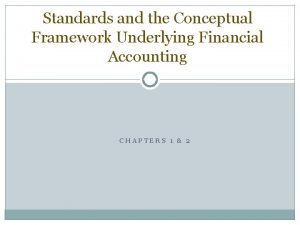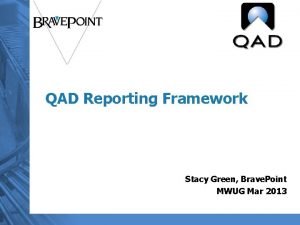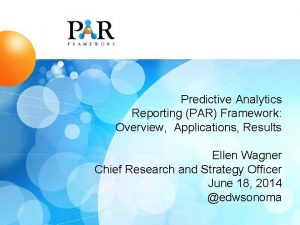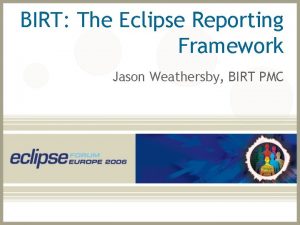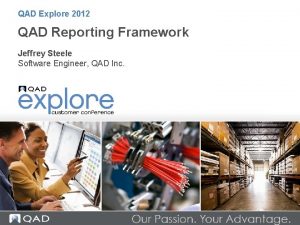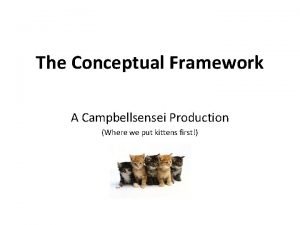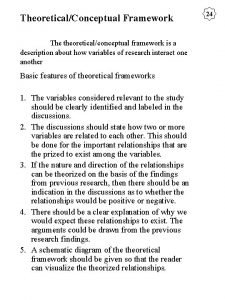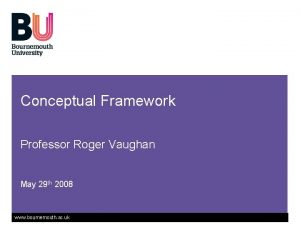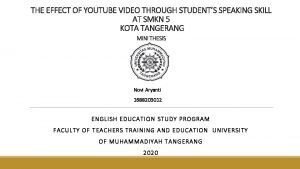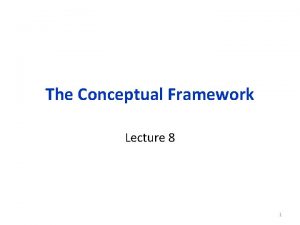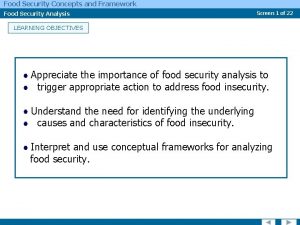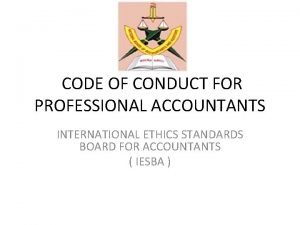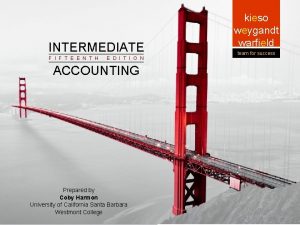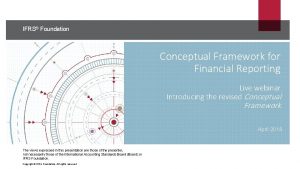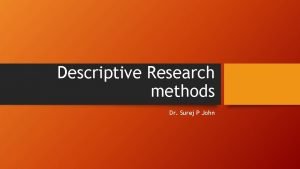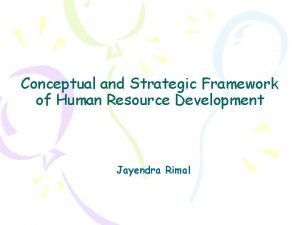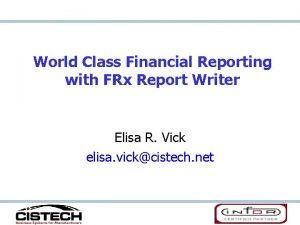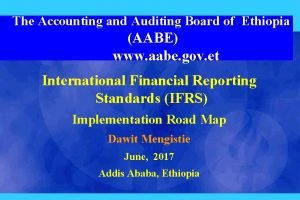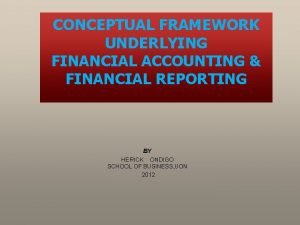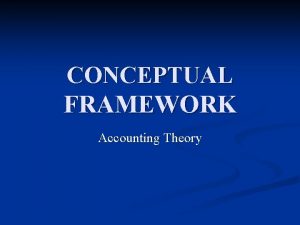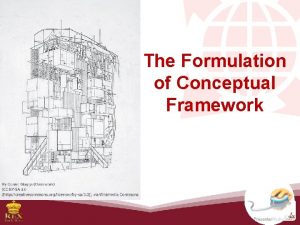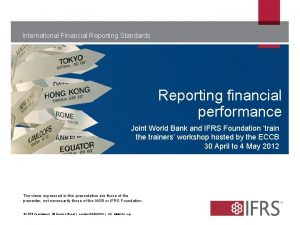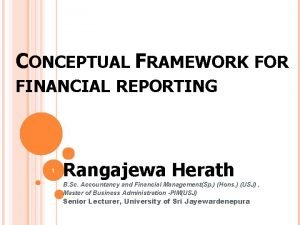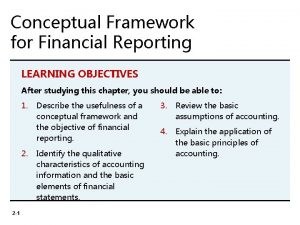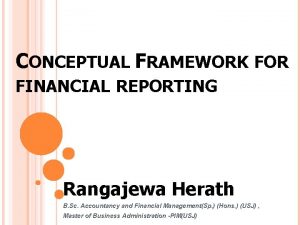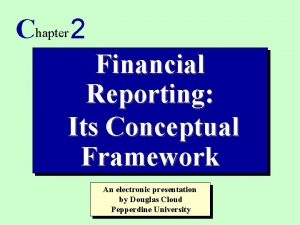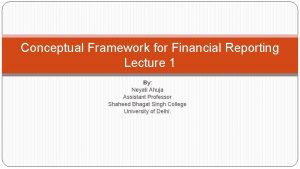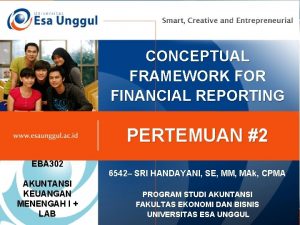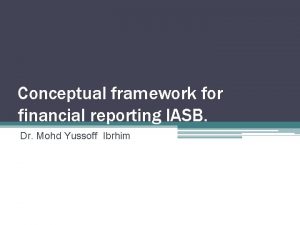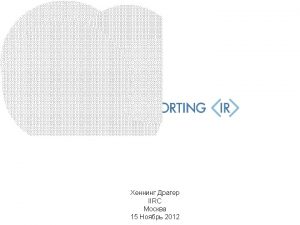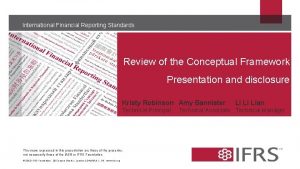International Financial Reporting StandardsIFRS Conceptual Framework for Financial













































- Slides: 45

International Financial Reporting Standards(IFRS) Conceptual Framework for Financial Reporting K

Conceptual Framework establishes the concepts that underlie financial reporting. Need for a Conceptual Framework Rule-making should build on and relate to an established body of concepts. Enables IASB to issue more useful and consistent pronouncements over time.

Purpose • • • To assist IASB in setting standards To serve as a basis for harmonisation To assist national standard-setters To assist preparers, auditors and users To assist in understanding of standard-setting To reduce conflicts between Framework and Standards

Role of the Conceptual Framework 4 • Conceptual Framework sets out agreed concepts that underlie financial reporting – objective, qualitative characteristics, element definitions, … • IASB uses Conceptual Framework to set standards – enhances consistency across standards – enhances consistency over time as Board members change – provides benchmark for judgments • Preparers use Conceptual Framework to develop accounting policies in the absence of specific standard or interpretation – IAS 8 hierarchy

Objective of financial reporting 5 Provide financial information about the reporting entity that is useful to existing and potential investors, lenders and other creditors in making decisions about providing resources to the entity Note: • other aspects of the Conceptual Framework flow logically from the objective (CF. OB 1) • Conceptual Framework sets out the concepts that underlie IFRS financial statements and assist the IASB in the development of future IFRSs and in its review of existing IFRSs (CF. Purpose and Status)

Objective of financial reporting 6 • Investors’, lenders’ and other creditors’ expectations about returns depend on their assessment of the amount, timing and uncertainty of (the prospects for) future net cash inflows to the entity. – Decisions by investors about buying, selling or holding equity and debt instruments depend on the returns that they expect from an investment in those instruments, eg dividends, principal and interest payments or market price increases. – Decisions by lenders about providing or settling loans and other forms of credit depend on the principal and interest payments or other returns that they expect.

Objective of financial reporting 7 • To assess an entity’s prospects for future net cash inflows, existing and potential investors, lenders and other creditors need information about: – the resources of the entity; – claims against the entity; and – how efficiently and effectively the entity's management and governing board have discharged their responsibilities to use the entity's resources – eg protecting the entity's resources from unfavourable effects of economic factors such as price and technological changes

Quiz: purpose of the Conceptual Framework for Financial Reporting Question 1: The purpose of the Conceptual Framework for Financial Reporting is: a. to assist the IASB in setting IFRSs? b. to assist preparers of financial statements in applying IFRSs? c. to assist auditors in forming an opinion on whether financial statements comply with IFRSs? d. to assist users of financial statements in interpreting IFRS financial statements? e. all of the above? © IFRS Foundation | 30 Cannon Street | London EC 4 M 6 XH | UK. www. ifrs. org 8

Quiz: purpose of the Conceptual Framework for Financial Reporting Question 1: The purpose of the Conceptual Framework for Financial Reporting is: a. to assist the IASB in setting IFRSs? b. to assist preparers of financial statements in applying IFRSs? c. to assist auditors in forming an opinion on whether financial statements comply with IFRSs? d. to assist users of financial statements in interpreting IFRS financial statements? e. all of the above? 9

Quiz: objective of general purpose of financial reporting Question 2: The objective of general purpose financial reporting is: a. provide financial information about the reporting entity that is useful to existing and potential investors, lenders and other creditors in making decisions about providing resources to the entity? b. to inform government statistics? c. to support the entity’s tax return? © IFRS Foundation | 30 Cannon Street | London EC 4 M 6 XH | UK. www. ifrs. org 10

Quiz: objective of general purpose of financial reporting Question 2: The objective of general purpose financial reporting is: d. to meet all the information needs of all the users of an entity’s financial statements? e. to inform economic decision-making by a broad range of users (including managers, investors, creditors and prudential regulators)? © IFRS Foundation | 30 Cannon Street | London EC 4 M 6 XH | UK. www. ifrs. org 11

Quiz: objective of general purpose of financial reporting Question 2: The objective of general purpose financial reporting is: a. provide financial information about the reporting entity that is useful to existing and potential investors, lenders and other creditors in making decisions about providing resources to the entity? b. to inform government statistics? c. to support the entity’s tax return? d. to meet all the information needs of all the users of an entity’s financial statements? e. to inform economic decision-making by a broad range of users (including managers, investors, creditors and prudential 12 regulators)?

Qualitative characteristics 13 • If financial information is to be useful, it must be relevant and faithfully represent what it purports to represent (ie fundamental qualities). – Financial information without both relevance and faithful representation is not useful, and it cannot be made useful by being more comparable, verifiable, timely or understandable. • The usefulness of financial information is enhanced if it is comparable, verifiable, timely and understandable (ie enhancing qualities—less critical but still highly desirable) – Financial information that is relevant and faithfully represented may still be useful even if it does not have any of the enhancing qualitative characteristics. © IFRS Foundation | 30 Cannon Street | London EC 4 M 6 XH | UK. www. ifrs. org

Fundamental qualitative characteristics 14 • Relevance: capable of making a difference in users’ decisions – predictive value – confirmatory value – materiality (entity-specific) • Faithful representation: faithfully represents the phenomena it purports to represent – completeness (depiction including numbers and words) – neutrality (unbiased) – free from error (ideally) Note: faithful representation replaces reliability © IFRS Foundation | 30 Cannon Street | London EC 4 M 6 XH | UK. www. ifrs. org

Enhancing Qualitative Characteristics 15 • Comparability: like things look alike; different things look different • Verifiability: knowledgeable and independent observers could reach consensus, but not necessarily complete agreement, that a depiction is a faithful representation • Timeliness: having information available to decisionmakers in time to be capable of influencing their decisions • Understandability: Classify, characterise, and present information clearly and concisely

Pervasive constraint 16 • Reporting financial information imposes costs, and it is important that those costs are justified by the benefits of reporting that information. • Benefits include more efficient functioning of capital markets and a lower cost of capital for the economy. • Costs include collecting, processing, verifying and disseminating financial information and the costs of analysing and interpreting the information provided. • In applying the cost constraint, the IASB assesses whether the benefits of reporting particular information are likely to justify the costs incurred to provide and use that information. Those assessments are usually based on a combination of quantitative and qualitative information.

Quiz: objective of general purpose financial reporting 17 Question 3: Which of the following could most closely be associated with the objective of financial reporting: a. have a bias toward understating assets and income and overstating liabilities and expenses? b. transparency and neutrality? c. financial stability through conservatism/prudence? d. management discretion in reporting financial information? 17

Quiz: objective of general purpose financial reporting 18 Question 3: Which of the following could most closely be associated with the objective of financial reporting: a. have a bias toward understating assets and income and overstating liabilities and expenses? b. transparency and neutrality? c. financial stability through conservatism/prudence? d. management discretion in reporting financial information? 18

Quiz: fundamental qualitative characteristics 19 Question 4: The fundamental qualitative characteristics are: a. comparability and relevance? b. relevance and reliability? c. relevance, reliability and comparability? d. relevance and faithful representation? e. comparability, relevance and faithful representation? 19

Quiz: fundamental qualitative characteristics Exercise: Identify the qualitative characteristic(s) to be used given the information provided. Characteristics (a) Qualitative characteristic being employed when companies in the same industry are using the same accounting principles. Relevance (b) Quality of information that confirms users’ earlier expectations. Confirmatory value (c) Imperative for providing comparisons of a company from period to period. Completeness (d) Ignores the economic consequences of a standard or rule. Verifiability Faithful representation Predictive value Neutrality Timeliness Understandability Comparability

Quiz: fundamental qualitative characteristics Exercise: Identify the qualitative characteristic(s) to be used given the information provided. Characteristics (e) Requires a high degree of consensus among individuals on a given measurement. Relevance (f) Predictive value is an ingredient of this fundamental quality of information. Confirmatory value (g) Qualitative characteristics that enhance both relevance and faithful representation. Completeness Faithful representation Predictive value Neutrality Timeliness Verifiability Understandability Comparability

Quiz: fundamental qualitative characteristics Exercise: Identify the qualitative characteristic(s) to be used given the information provided. Characteristics (h) Neutrality and completeness are ingredients of this fundamental quality of accounting information. Relevance (i) Two fundamental qualities that make accounting information useful for decisionmaking purposes. Confirmatory value (j) Issuance of interim reports is an example of what enhancing ingredient? Timeliness Faithful representation Predictive value Neutrality Completeness Verifiability Understandability Comparability

Summary 23 • Reporting financial information that is relevant and faithfully represents what it purports to represent helps users to make decisions with more confidence (ie financial information must possess the fundamental qualitative characteristics). • IFRS requirements must be cost-beneficial • Applying the enhancing qualitative characteristics is an iterative process that does not follow a prescribed order. Sometimes, one enhancing qualitative characteristic may have to be diminished to maximise another qualitative characteristic.

Quiz: qualitative characteristics 24 Question 5: which statement/s are true? a. Relevance is a fundamental qualitative characteristic. b. Financial information without both relevance and faithful representation is not useful. c. Financial information without both relevance and faithful representation cannot be made useful by being more comparable, verifiable, timely or understandable. 24

Quiz: qualitative characteristics 25 Question 5: which of the statements below are true? d. Financial information that is relevant and faithfully represented may still be useful even if it does not have any of the enhancing qualitative characteristics e. All of the above statements. f. None of the above statements. 25

Quiz: qualitative characteristics 26 Question 5: which of the statements below are true? d. Financial information that is relevant and faithfully represented may still be useful even if it does not have any of the enhancing qualitative characteristics e. All of the above statements. f. None of the above statements. 26

Elements 27 • Asset: Resource controlled as a result of past events and from which future economic benefits are expected to flow • Liability: Present obligation arising from past events, the settlement of which is expected to result in outflow of resources embodying economic benefits • Equity: Assets minus liabilities • Income (expense): Increases (decreases) in economic benefits during period from inflows or enhancements (outflows or depletions) of assets (liabilities) or decreases (incurrences) of liabilities from in increases (decreases) in equity, other than contributions from (distributions to) equity © IFRS Foundation | 30 Cannon Street | London EC 4 M 6 XH | UK. www. ifrs. org

Recognition 28 • Accrual basis of accounting – recognise element (eg asset) when satisfy definition and recognition criteria • Recognise item that meets element definition when – probable that benefits will flow to/from the entity – has cost or value that can measured reliably

Recognition 29 What does probable mean? The meaning of probable is determined at the standards level. Therefore, inconsistent use across IFRSs What does measure reliably mean? To a large extent, financial reports are based on estimates, judgements and models rather than exact depictions.

Measurement concepts 30 • Measurement is the process of determining monetary amounts at which elements are recognised and carried. (CF. 4. 54) • To a large extent, financial reports are based on estimates, judgements and models rather than exact depictions. The Framework establishes the concepts that underlie those estimates, judgements and models (CF. OB 11) • IASB guided by objective and qualitative characteristics when specifying measurements.

Presentation and disclosure 31 • Objective of financial reporting • Presentation: financial statements portray financial effects of transactions and events by: – grouping into broad classes (the elements, eg asset) – sub-classify elements (eg assets sub-classified by their nature or function in the business) • IAS 1 – application of IFRSs with additional disclosures when necessary results in a fair presentation (faithful representation of transactions, events and conditions) – don’t offset assets & liabilities or income & expenses

Derecognition of assets 32 • Derecognition of an asset refers to when an asset previously recognised by an entity is removed from the entity’s statement of financial position – derecognition requirements are specified at the standards level. – derecognition does not necessarily occur when the asset no longer satisfies the conditions specified for its initial recognition (ie derecognition does not necessarily coincide with the loss of control of the asset ) • IASB guided by objective, qualitative characteristics and elements

Quiz: recognition 33 Question 7: Expenses are recognised in comprehensive income (profit or OCI): a. using the matching basis—on the basis of a direct association between the costs incurred and the earning of specific items of income? b. using the accrual basis—items are recognised as assets, liabilities, equity, income or expenses when they satisfy the definitions and recognition criteria for those items? c. at the discretion of management? 33

Quiz: recognition 34 Question 7: Expenses are recognised in comprehensive income (profit or OCI): a. using the matching basis—on the basis of a direct association between the costs incurred and the earning of specific items of income? b. using the accrual basis—items are recognised as assets, liabilities, equity, income or expenses when they satisfy the definitions and recognition criteria for those items? c. at the discretion of management? 34

Quiz: uncertain future cash flows 35 Question 8: Recognition criteria determine when to recognise an item. Measurement is determining the monetary amounts at which to measure an item. Uncertainties about the extent of future cash flows: a. only affect the decision about whether to recognise? b. only affect the estimation of the amount at which to measure the item? c. could affect both recognition and measurement? 35

Quiz: uncertain future cash flows 36 Question 8: Recognition criteria determine when to recognise an item. Measurement is determining the monetary amounts at which to measure an item. Uncertainties about the extent of future cash flows: a. only affect the decision about whether to recognise? b. only affect the estimation of the amount at which to measure the item? c. could affect both recognition and measurement? 36

Quiz: measurement 37 Question 9: How many measurement bases does IFRSs specify for the measurement of assets? a. b. c. d. one—historical cost one—fair value two—historical cost and fair value many—including historical cost, fair value, value in use, estimated selling price less costs to complete and sell, etc © IFRS Foundation | 30 Cannon Street | London EC 4 M 6 XH | UK. www. ifrs. org 37

Quiz: measurement 38 Question 9: How many measurement bases does the IFRSs specify for the measurement of assets? a. b. c. d. one—historical cost one—fair value two—historical cost and fair value many—including historical cost, fair value, value in use, estimated selling price less costs to complete and sell, etc 38

Quiz: status of Conceptual Framework Question 10: the Conceptual Framework: a. is an IFRS? b. overrides all other IFRS requirements? c. does not define standards for any particular measurement or disclosure issue? d. is in the hierarchy that management must in the absence of a specific IFRS requirement apply in developing an accounting policy that results in information that is relevant? 39 39

Quiz: status of Conceptual Framework Question 10: the Conceptual Framework: a. is an IFRS? b. overrides all other IFRS requirements? c. does not define standards for any particular measurement or disclosure issue? d. is in the hierarchy that management must in the absence of a specific IFRS requirement apply in developing an accounting policy that results in information that is relevant? 40 40

Common ‘conceptual’ misunderstandings 41 The Framework does Clarification—the not… Framework includes include a matching concept accrual basis of accounting —recognise elements when satisfy definition and recognition criteria include neutrality concept prudence/conservatism concept include an element other only the following elements comprehensive income (or —asset, liability, equity, a concept for OCI) income and expense mention management © IFRS Foundation | 30 Cannon Street | London EC 4 M 6 XH | UK. www. ifrs. org

Common ‘conceptual’ misunderstandings continued 42 Misunderstanding Clarification Uniformity = comparability Comparability is achieved when like things are accounted for in the same way. Comparability is not achieve when accounting rules require unlike things be accounted for in the same way

Common ‘conceptual’ misunderstandings continued Misunderstanding There is a clear concept for the historical cost of an item 43 Clarification The Framework provides only a vague description— assets are recorded at the amount of cash or cash equivalents paid or the fair value of the consideration given to acquire them at the time of their acquisition. What is cost when: - advance/deferred payment? - purchased option

Common ‘conceptual’ misunderstandings continued Misunderstanding Principles are necessarily less rigorous than rules There are few judgements and estimates in costbased measurements 44 Clarification Rules are the tools of financial engineers Inventory, eg allocate joint costs and production overheads PPE, eg costs to dismantle/restore site, useful life, residual value, depreciation method Provisions, eg uncertain timing and amount of expected future cash flows

Questions or comments? 45
 Second level of conceptual framework
Second level of conceptual framework Intermediate accounting chapter 2
Intermediate accounting chapter 2 Conceptual framework underlying financial accounting
Conceptual framework underlying financial accounting How to make theoretical framework
How to make theoretical framework Drawing a conceptual framework
Drawing a conceptual framework Conceptual framework theoretical framework
Conceptual framework theoretical framework Theoretical framework example
Theoretical framework example Cbd financial reporting framework
Cbd financial reporting framework International financial reporting standards 9
International financial reporting standards 9 Conceptual framework of financial accounting
Conceptual framework of financial accounting Conceptual framework underlying financial accounting
Conceptual framework underlying financial accounting D-mwug
D-mwug Predictive analytics reporting (par) framework
Predictive analytics reporting (par) framework Java reporting framework
Java reporting framework Curriculum assessment and reporting framework
Curriculum assessment and reporting framework Qad reporting framework
Qad reporting framework Qsa assessment bank
Qsa assessment bank Conceptual framework on the causes of malnutrition
Conceptual framework on the causes of malnutrition Conceptual framework art
Conceptual framework art What is input in conceptual framework
What is input in conceptual framework Hypothesis development adalah
Hypothesis development adalah Tracer study conceptual framework
Tracer study conceptual framework Iot conceptual view
Iot conceptual view Conceptual and theoretical framework
Conceptual and theoretical framework Conceptual framework of malnutrition
Conceptual framework of malnutrition Conceptual framework for interactive graphics
Conceptual framework for interactive graphics The underlying theme of the conceptual framework is
The underlying theme of the conceptual framework is Main variable in research
Main variable in research Isometric perspective art definition
Isometric perspective art definition Matthew vaughan cairns
Matthew vaughan cairns Conceptual framework youtube
Conceptual framework youtube Source of conceptual framework
Source of conceptual framework The conceptual framework that underlies ifrs
The conceptual framework that underlies ifrs Macro practice conceptual framework
Macro practice conceptual framework What is conceptual framework of science education
What is conceptual framework of science education Food security conceptual framework
Food security conceptual framework The conceptual framework in the aicpa code establishes a
The conceptual framework in the aicpa code establishes a Theoretical and conceptual framework
Theoretical and conceptual framework Qualitative characteristics of accounting
Qualitative characteristics of accounting Fasb conceptual framework diagram
Fasb conceptual framework diagram Foundation of conceptual framework
Foundation of conceptual framework What is descriptive survey design
What is descriptive survey design Conceptual framework of human resource development
Conceptual framework of human resource development Frx designer
Frx designer Aabe ethiopia website
Aabe ethiopia website Purpose of financial report
Purpose of financial report


